
How the jantar mantar instruments works
This article is the concluding part of my article titled “Temple of instruments-Jantar mantar”. In preceding article, we saw the overview of various scientific astronomical instruments of jantar mantar made completely of stone, marble and bronze with some additional ductile use of copper, tin and zinc to avoid rusting of stonework. In this article, we will see the scientific explanation on the working of these instruments along with its limitations.
Types of instruments
Totally, there are fourteen different kinds of instruments for various astronomical measurements. Out of these, 12 instruments were built specifically to measure the latitude and longitude of celestial objects. Some of the instruments names are
Samrat Yantra
Prakash Yantra (Great and Small)
Misra yantra
Rama Yantra
Dakshino Bhitti Yantra
Digamsa Yantra
Rashi Valaya Yantra
Shastansha Yantra
Unnatasha Yantra
Narivalaya Uttar Gola Yantra
Though the operations and functioning of all these instruments varies with each other, some of them were especially built to complement other instrument. For Example, Digamsa Yantra complemented rama yantra to remove the limitation of taking into consideration the altitudinal reading of stars in specific locations.
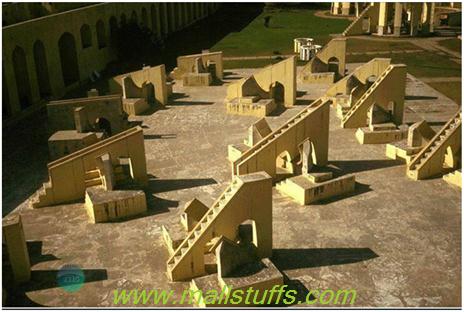
Restoration work was done in the early nineteenth century using brick powder thus giving an attractive reddish hue. Except Misra yantra(scales made of white marble
), scales of all other instruments are finished with white plaster. Unlike traditional Indian architectural style, these architectural pieces lack any surface carving or decorations. As every sun movement forms a unique pattern on earth and most of the astronomical events are linked to movement of sun, the resulting sun shadow on these instruments is used to determine various astronomical events.
Co-ordinate measurement techniques used
Astronomically, below are the four basic co-ordinate measurement techniques to locate the position of universal objects in celestial space.
| Location | Base Circle | Base Point | Coordinates |
| Earth | Equator | Where Greenwich Meridian Intersects the Equator | Latitude and Longitude |
| Celestial sphere | Horizon | Due North | Altitude and Azimuth |
| Celestial sphere | Celestial equator | Spring Equinox | Declination and Right Ascension |
>| Celestial sphere | Ecliptic | Spring Equinox | Latitude and Longitude |
However, the instruments in Jaipur ‘jantar mantar’ uses the slightly different measurement technique. For EX: Instead of using due north, ‘Jai prakash’ and ‘samrat’ yantra uses zenith as their base point with horizon as their base circle.
According to different co-ordinate system, instruments at Jaipur observatory can be categorized as:
The Horizon and Zenith.
The Equator and Earth’s axis.
The Ecliptic and Ecliptic pole.
Five major instruments along with their co-ordinate measurement systems are:
|
Instruments | System Based on | Coordinates Measurements |
| The Digamsa | Horizon and Zenith | Altitude and Azimuth |
| The Rama | Horizon and Zenith | Altitude and Azimuth |
| The Digamsa | Horizon and Zenith | Altitude and Azimuth |
| The Samrat | Equator and Earth�s axis | Declination and Right Ascension |
| The Rashi Valaya | Ecliptic and Pole of the Ecliptic | Latitude and Longitude |
| Jai Prakash | Horizon and Zenith, Polaris and the Celestial equator | Altitude and Azimuth,Declination and Right Ascension |
Each of these instruments works on the above three listed coordinate systems. Some of the instruments like Kapala Yantra worked on two co-ordinate systems by transforming coordinate of one system to the other. Above astronomical instruments is the most impressive and unique collection of pre-telescopic era.
Details of each instrument
The Digamsa Yantra
Digamsa yantra was constructed to assist Rama yantra in proving accurate azimuthal readings and so, its design is relatively less complex than Jai prakash and Ram yantra.
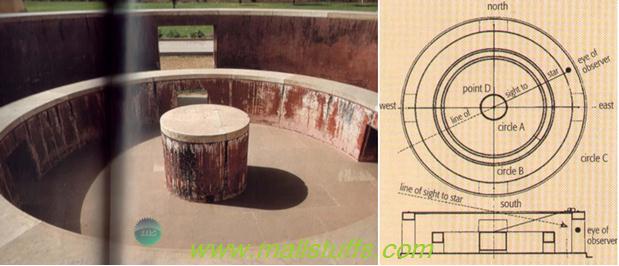
As you can see above, Digamsa Yantra is basically a circular drum like structure in the middle surrounded by two circular walls, second circular wall having twice the height of first circular wall(height same as central drum). Azimuthal scales were engraved on top of each pillar and circular walls (made of marble covering the entire circular shape of the pillar or wall). Two wires, one in north-south direction and other in east-west direction were suspended from top of second circular wall. These two wires were intersected at the exact center of central pillar (which is in line with zenith). Additionally, a loose thread was fixed at this intersection point for measurement purposes.
Function
Initially, observer is positioned between 1st and 2nd wall and his assistant at the outer side of 2nd wall. Then the observer moves along the path between the two walls till the star gets aligned with the intersection point of the wires. The assistant complements the observer by pulling the hanging thread along the azimuthal scale of outer wall until the position of star under observation, intersection point of wires and hanging thread are in same line.
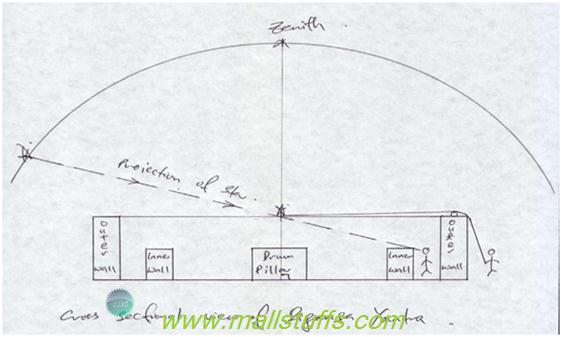
Rashi-Valaya Yantras
As the name suggests, these yantras was used for predicting horoscope (Rashi). Construction is very similar to samrat yantra except the slope of gnomon for each of the twelve Rashis(Zodiac signs). Originally intended to be constructed symmetrically on a platform representing horizon, symmetry was not precise due to the southward shift of Gemini and Aquarius yantras with respect to Leo and Sagittarius yantras.
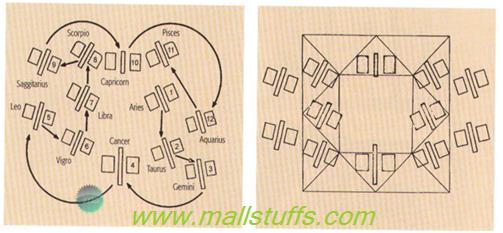
This defect in symmetry was due to the building constructed just outside the observatory that obstructed the necessary orientation of instrument with each of the compass directions. This also means that this building was constructed before the design of these twelve yantras.
Sun completes its one revolution along its elliptic path in one solar year (365 days). Position of twelve zodiac constellation in the celestial space is fixed. Position of the sun with respect to these twelve constellations changes roughly every one month. For an observer on earth, there are six zodiac constellations on either side of the earth. Hence, an observer can see only six constellations at night time when the sun is below horizon and the other six constellations, which would be visible only during day time, cannot be seen because of the bright illumination of the sun or obstruction by clouds.
Rashi-Valaya yantra calculated the exact position of zodiac constellations during daytime based on the movements of sun along its diurnal path. Thus, elliptical longitude and latitude was determined using the relative distance between the sun and other constellations measured by Rashi-Valaya yantra.

Rasivalaya Yantra
As the earth rotates around its axis, gnomon of one out of the twelve constructed rashi-Valaya yantra would be parallel to the elliptical axis at some point of the day. When this happens, sun is at the position exactly above one of the twelve yantras with no shadow of the walls on either side of the yantra. i.e sun is at the position of the corresponding zodiac constellation. Thus, Rashi Valaya Yantras was based on earth rotation and the movement of elliptical axis around earth axis.
Samrat yantra
Samrat(meaning supreme or huge) Yantra is the crown of this observatory. Standing 90 feet high and 114 feet long, it has a 10 feet thick structure with face tilting at latitude of jaipur(27 degrees) in N-S axis. Declining sunrays on this structure predicts the current time for the day. Tilting at 27 degrees was done to align the hypotenuse in line with celestial North Pole to measure the position of pole star (Dhruv tara).
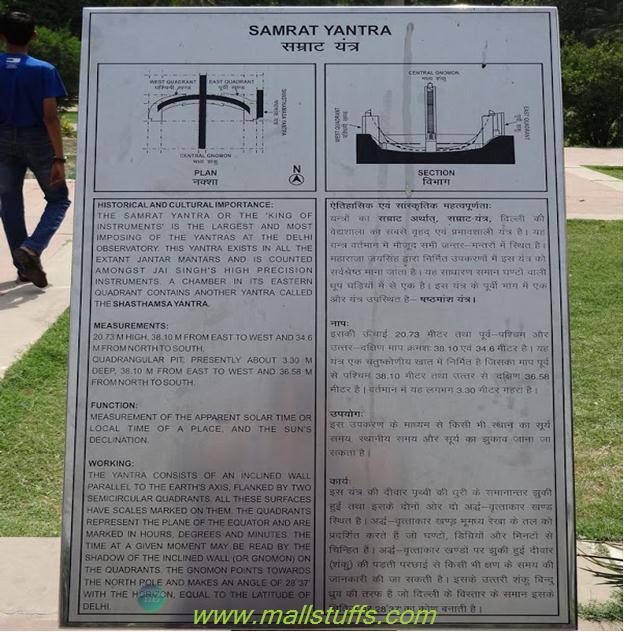
Constructed by king himself, Samrat Yantra is the undisputed largest sundial of the world that can tell the current time with an accuracy of 2 seconds. A small dome like structure known as chatri at the tip of this instrument would predict the climatic change, location of stars, eclipses or arrival of monsoon.
It is one of the best archeo-astronomical structures that showcase the fundamentals of using sundial to measure the current time of the day. There is two sundial with one, four times the bigger than the other one named ‘Laghu’. It is said that the dwarf one was built first but since it was less accurate, larger one was built later. Due to its massive size, it is visible from all surrounding structure and buildings outside the observatory.
Units finely divided into hours, minutes and seconds are notched on the surface of this and other calculating instruments to note the position of sun in the sky.
Geometrically, it is made up of two main structures, a semicircular surface and gnomon. Gnomon is made up of two triangular walls (right angled) in north south direction with base of hypotenuse towards south and apex at north. It also has staircases sandwiched between the right angled walls to have access to the highest point of samrat yantra.
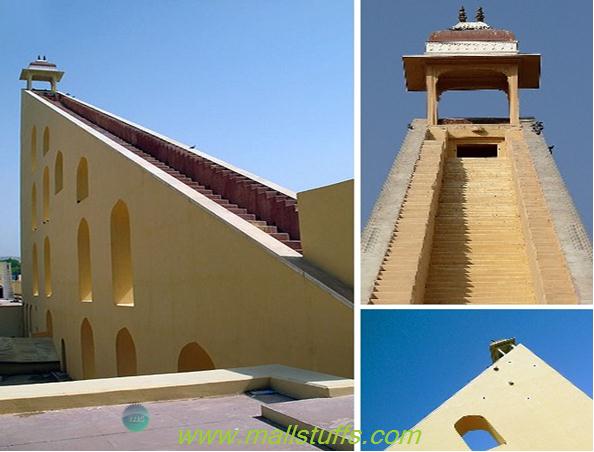
Measurements units are calibrated on both the edges of the staircase for measuring the zenith (Sun height in sky) of celestial bodies. Semicircle made of two calibrated curved quadrants intersects the gnomon at an angle parallel to earth equator. Observer uses the staircases to predict the current time by measuring the marking on curved quadrants of this semicircle, following the falling shadow of the gnomon. Staircases let the observer watch shadow on each part of the gnomon
Sun position in sky is predicted by determining which part of the gnomon is casting shadow on the curved quadrant.
As the sun moves from east to west, shadows created by walls of samrat yantra creeps on the earth surface. At local noon, sun is at exact top of the hypotenuse of right triangle.
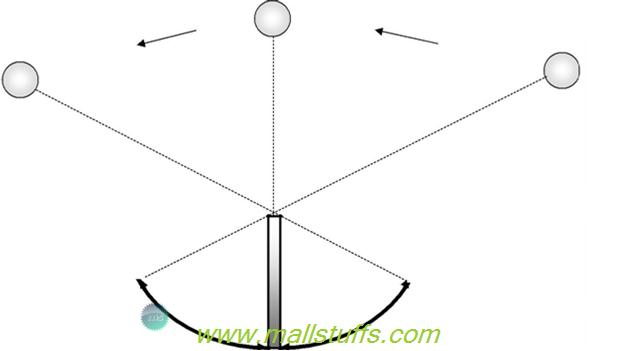
These gradual movements allowed the observer to predict the time by watching the shadow on markings at different time of the day. The first measurement at daybreak and last measurement at sunset determine the duration of the day and then, these detailed measurements was then used to predict the current season and upcoming season. Shadow on gnomon moves 4 m/hr or 6cm/min or 1 mm/sec thus presenting an accuracy of 2 seconds though the claims varies from Half a second to half a minute.
Though Jai singh thought of having accuracy through large size structures, he failed to overlook the fundamental flaw-i.e Shade diffraction. Light source illuminating the object does not have clearly defined boundaries for the volume of shadow created by the object undertaking the concept of partial and full shadow. Light source will always create an area of full shadow known as Umbra and area of partial shadow known as penumbra.
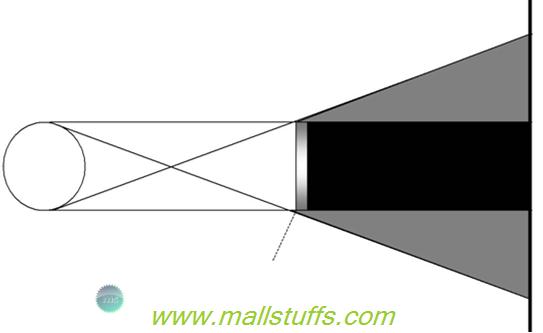 .
.
Because of the massive size of sun and its large distance from earth, sun always emits sun rays parallel to the earth. This totally contrasts the idea of light source with rays emanating outwards from a single point. Hence, the time measurement using sun shadow would have been more precise if the structure was built smaller and closer to ground. Increase in size has thus added problem in time measurement and with 2 seconds being 0.2 centimeters on measurement scale, partial shadow would account for poor astronomical predictions.
Effects of Shade diffraction was fixed by Indian seers by using a small lead made sidestick.
In accordance with the shadow casted by gnomon on curved quadrants, this sidestick was moved up and down along the ramp to derive the exact measurement of time. The effective use of such tools make samrat yantra the world most effective and precise sundial.
Though jai singh was aware of small sized astronomical instruments like alidades, telescopes and other european instruments that were more precise, he showed little interest in them and erected large sized metal instrument for socio-political reasons. He
not only wanted to display his astronomical knowledge but also the traditional architectural Indian style and his relationship with the divine celestial beings.
Jai Prakash Yantra
Jai prakash yantra refers to the pair of complementary hollow hemisphere bowls about 8.3 meters in diameter, made of marble with markings on their concave surfaces to measure the azimuth, declination, ascension lines and altitude of celestial bodies. Additionally, celestial markers such as zenith and North Pole were inscribed on the hemisphere to give additional details of sun and stars. With an overall depth of 5.5 meters, half of Jai Prakash Yantra is below the ground and half above the ground. Jai prakash yantra was designed with the idea of the grounded hollow hemisphere inversely showing the above heavenly bodies in the sky.
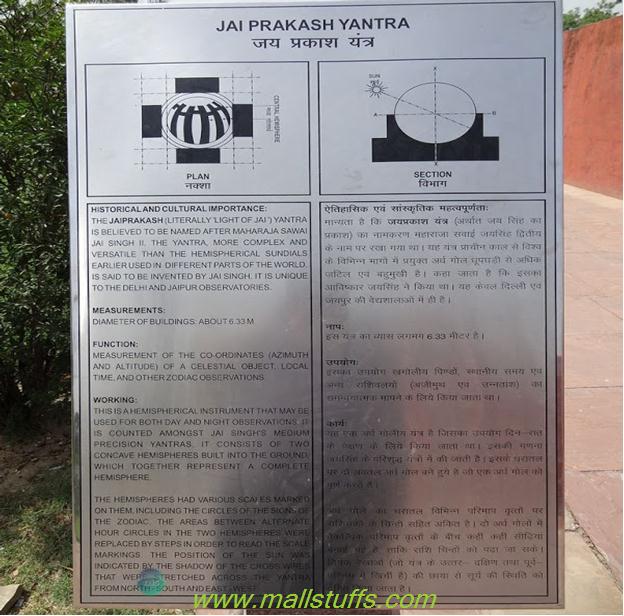
Each hemisphere had open spaces that acted as the staircase to let the observer stand inside the yantra and map the position of the star using marking along the rim constructed open to the sky and parallel to horizontal surface.
The feature of hollow section of one hemisphere complementing the solid section of another allows the observer to take reading of heavenly bodies at nighttime, a feature unique to this sundial. Every point of the sky is reflected on the corresponding point on the metal ring, held by stretched crosswire across the center of the hemisphere bowl. The shadow falling on the concave surface, at the intersection point of two crosswire, indicated the path and location of the sun.
Sunshine passes though the hole at the bottom of this yantra only once in a year i.e at the time of vernal equinox (21 march). Thus an inverted image of the sky is formed on this concave surface where the horizon is represented by the rim of hemispheres and zenith by the lowest point.
Small Great Jai Prakash Yantra
Scales aligned to four compass directions were inscribed on the open top of the hemisphere. Horizontal base below represents the horizon of the observer. Crosswire strings secured at the four compass directions hold a metal ring at the point of its intersection. This intersection point is the lowest point of the hemisphere and was used to represent zenith due to its celestial counterpart exactly perpendicular to the horizon.
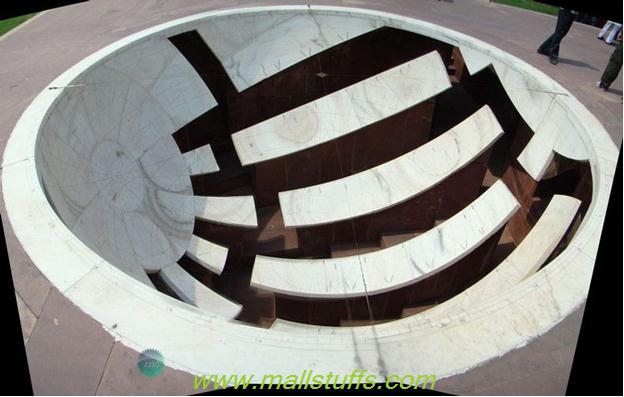
Altitude markings of concentric circular lines intersect with the azimuthal circular lines coming from fixed intervals of horizontal azimuthal scale. They met the marked zenith at the bottom of the hemisphere.
Another coordinate system, the Celestial Equatorial system is also inscribed onto the sunken hemisphere. Additionally, north celestial pole is also inscribed at a specific angle with respect to horizon in the hemisphere. This angular difference represents the geographical latitude of Jaipur(27 degrees). Declination lines are represented by large concentric circular lines engraved around the north celestial pole. Right ascensions lines are represented by concentric circular lines perpendicular to the declination lines. All these concentric measurement lines represent the scale of second coordinate measurement system.
How it Works
Metal ring at the bottom of hemisphere (Zenith) acts as a gnomon. Sun movement in the sky during daytime creates a shadow on the surface of this hemisphere. Two different c-ordinate measurement systems doubles the accuracy of the undertaken readings.
Limitations
It will not work if clouds block the sun. Though the sun shadow is clearly visible on the marble surface, the same was not applicable for other stars. Observation of stars would have been possible if the instrument was made of some transparent material instead of white marble but this would have made the observation of sun difficult since the shadow of centric ring would pass the transparent surface. To solve this problem, there was a need for two instruments: marble one for observing sun and a transparent one for observing stars.
The Great Jai Prakash Yantra
Jai singh was smart to understand the limitation of Small Jai Prakash Yantras and hence created another bigger Jai Prakash Yantra.
Description
Hemisphere was enlarged and surface divided into different sections. Second hemisphere was built in such a way that the gaps between the pieces of first hemisphere fitted inside the gaps between the pieces of second hemisphere thus making the combination, the complete whole.
How it works
Gaps between the pieces acted as the gateway or staircase, to let the observer go right up to the edge of the hemisphere or align his eye to the slab surface level and view the stars directly with naked eye. Since the observer had to align his eye on the scales and stars alternatively, accurate measurement of the stars from the edges of slabs was quite not possible. So, the slabs were later divided into longitude with 15 degrees interval to let the accurate readings to be taken only if the observer had orbited fifteen degrees.
Conceptually, the great prakash yantra was significantly similar to the smaller one and was different only in physical size and division of its hemisphere surface. Jai prakash was the most accurate of all instruments and so, was used to calibrate other instruments. Jai Prakash yantra is much more complex, elaborate and versatile then his entire predecessors in china & European countries and the only instrument based on two different coordinates systems(celestial equatorial and horizontal systems) for greater accuracy.
Ram yantra
Ram yantra is made up of two large cylindrical building with an open top along the north-south axis. Based on the zenith and horizon co-ordinate system, these two Roman Coliseums like buildings measures the latitude and longitude of the stars. Unlike Jai Prakash Yantra which uses metallic ring as its gnomon, Rama yantra uses a one and half meter vertical pole installed at the center of the scaled circular surface as its gnomon. Buildings are sunk two meters into the ground. Three tiered circular walls of this building are slightly slanted at each level. 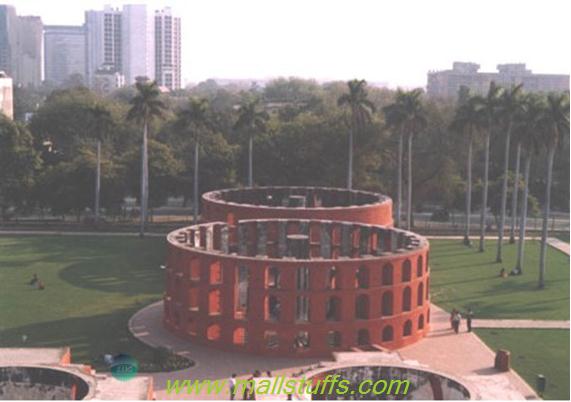
One meter thick at the bottom, the wall is punctures at regular interval with keel-arched openings (about 1.5 meters tall for the top two tiers and 1 meter tall for the lowest tier). Height of each pillar and wall is equal to radius of inner building. At height of one meter from the ground, red sandstone floor divided into equal sectors radiates from the central pillar. Readings on the solid sector is facilitated by the removal of every alternate sector.
Walls are placed at regular interval of twelve and eighteen degrees to let the observer walk along the scales to make the necessary observations. The combination of twelve degree and eighteen-degree flans formed a complete circle.
Like jai prakash yantra, these complementary buildings were mainly built to facilitate the readings of heavenly bodies at nighttime. Concentric circular scales divided into degrees and minutes are engraved on circular slabs and interior walls to facilitate the azimuthal readings. Equally spaced radial lines on the bottom of the floor from central pole to the curved walls of the cylinder gives the altitude readings. Shadow of the pillar on the bottom surface of the buildings determines the co-ordinate of the sun. Top of shadow relative to semicircular scales gives the azimuth reading whereas the angle of shadow relative to radiating scales gives the altitude reading.
Celestial object observed from one of the cylinders of ram yantra and aligned with top edge of the pillar and point of observation gives the coordinates of the object. If the vantage point falls on the vertical surfaces of the cylinder, plank of wood is inserted between the openings of the curved walls on which the observer perch to take a reading. Observer would walk along the spaces between the flans to measure the altitude and azimuth of the sun, from the shadow casted by the gnomon onto the circular scale. Based on the shadow casted by gnomon, observer has to use the two Rama Yantras interchangeably. Since the shadow of the gnomon cannot miss the alternate scaled fans of both rama yantras, the observer has to switch between the two Rama Yantra to take readings. I.e if the shadow of the gnomon doesn’t fall in scaled fan of one rama yantra, the observer has to switch to the other rama yantra to take readings.
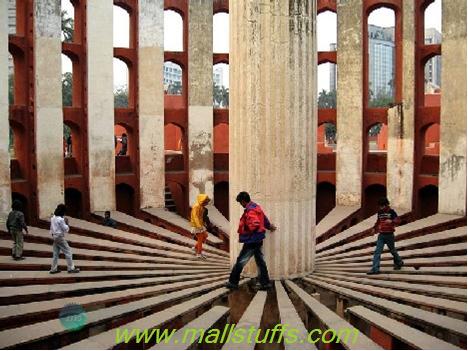
Sidereal Application
Reading a star was little more complicated than reading the sun. To read a star, observer would rotate around the rama yantra to select a flan such that the star, top of gnomon and edge of flan are in the same line. For Ex: if a particular star lies ninety degrees to the right of the gnomon at a particular flan, the observer would go to the flan ninety degrees relative to the present flan to get aligned with the top of the gnomon. For precise measurement, a thread attached at the top of the gnomon was pulled towards the edge of the present flan at an angle coinciding with the eye of the observer.
Radius of the flan is same as the length of the gnomon. This allowed stars only within an altitude of 45 degrees to be measurable on the scaled fans. Remaining stars with altitude lower than 45 degrees were projected tangentially onto the circular walls as shown in the below image
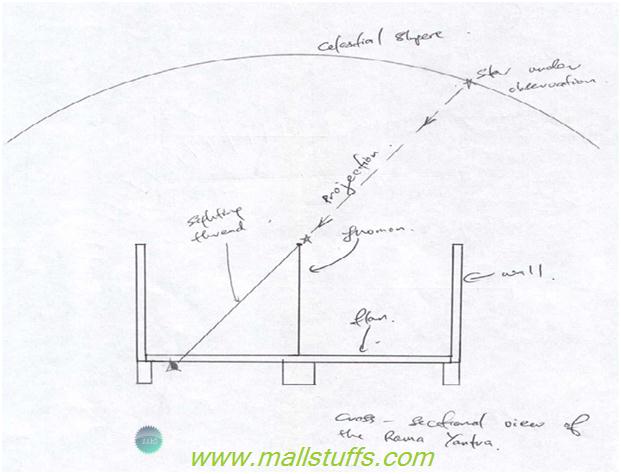
The Tangential Scale
Modern architects are surprised and are not able to understand how the ancient pundits managed to inscribe concentric circular lines onto the scale of the flans precisely.
Limitations of the Rama Yantra
Intersection point was often touched, especially in the case of observing two stars at very large altitude because at that time they would be very close to each other. This was overcome by using the co-ordinate measurement of the zenith and estimation of the stars near to zenith. Observing a star was possible only when the edges of scaled flans had completed twelve to eighteen degrees of its orbit. To overcome this limitation, the pundits and architects designed another instrument called Digamsa Yantra.
Misra Yantra
Misra yantra is a comparatively small instrument (25x12) formed by the combination of five instruments that measure the longest and shortest day of the year using its southwest pillars. This instrument can predict the exact noon time of not only Delhi but all other cities of the world irrespective of its distance from Delhi. Each stone made of marble is precisely curved and perfectly aligned with its neighbor.
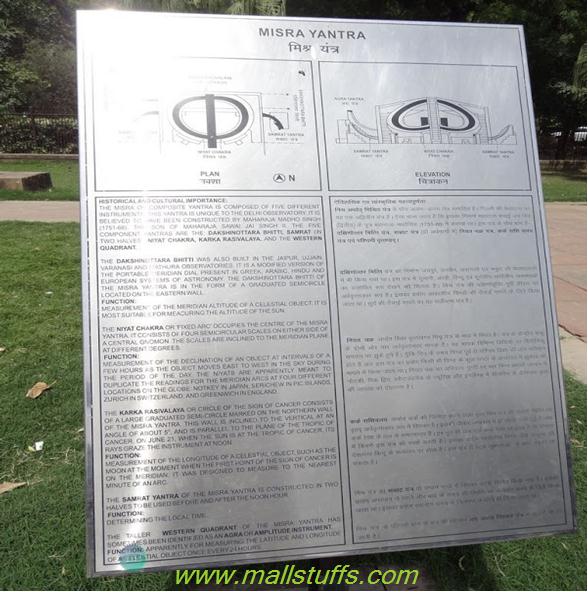
Misra Yantra is symmetric with respect to the centric wall whose upper edge is inclined at the same angle as the hypotenuse of Samrat Yantra. Two semicircular walls, with staircase 1 meter long sandwiched between them, allowed the observer to access every portion of this yantra.
Marble scales .5 meters wide are engraved on semicircular walls on either side of the gnomon with center as hypotenuse of central wall. Semicircular walls on western sides are inclined at angles corresponding to meridians of East Asia whereas the walls on the eastern side correspond to meridians of Zurich and Greenwich. Readings are taken by climbing the walls on either side of curved walls or the staircases between them, accessible by two meter wide doorways on either side of the gnomon. Additionally, this instrument has three more quadrants, one on the east and two on the western side of the gnomon.
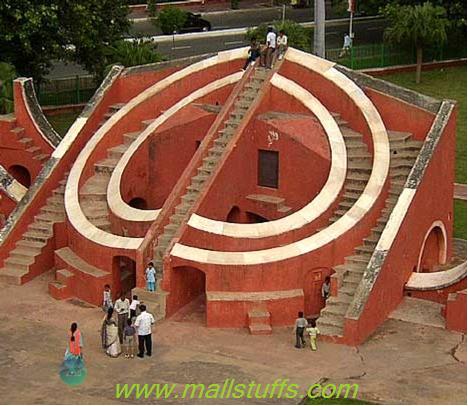
Conclusion:
It is no denying the fact that these structures represent the scientific heritage of India, though they are not used in the modern scientific research. Having said that, we must give accreditation to the Jantar Mantar for its scientific acumen which could have reaped more fruits, had there been appropriate motivation and resources provided for research and development. Hope the government takes sufficient steps to revive the rich ancient history and sanctity of India.
Reference: Book on jantar mantar by Iswen vellu & others
Note: Images used on this website
are either a production of Bhaktivedanta Book Trust(https://www.krishna.com), Iskcon
Foundation or were found in google search under "Free to use and share". If any
of the images presented here violates copyright issues or infringes anyone copyright
or are not under "Fair use", then please bring it to our notice. Read
Disclaimer for more.
Share this to your friends. One of your friend is
waiting for your share.
Related Articles
Why number 108 is holy and auspicious in Hinduism
Jantar Mantar-Temple of instruments
How the jantar mantar instruments works
Scientific Proof of lord Krishna existence
Post Comment